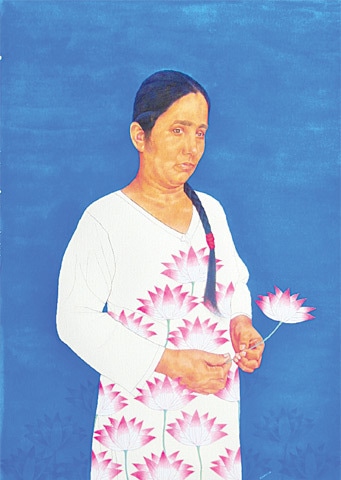In the growing milieu of political instability, the country faces numerous challenges, leaving a confused public in its wake. Artists across the country, who are relatively more sensitive to the situation, have been actively decrying the apathy of the leadership. In a similar context, an exhibition of contemporary miniature paintings titled No location, was held recently at the Chawkandi Art Gallery, Karachi showcasing six works of Hira Zubair and seven of Shamsuddin Tanwri.
Zubair maintains that her gouache-on-wasli work is mostly based on the country’s cultural roots and strives to promote the traditions that are diminishing. Some of her paintings with swirling vortices are inspired by the amazing Turkish art technique called Ebru which is produced by floating dyes on water. Being fascinated by the drapery and figures portrayed in Persian miniature painting, she takes frequent references of the same to personalise her paintings.
A striking feature of Zubair’s paintings is the addition of a three dimensional decoupage (the craft of enhancing objects with paper cut-outs). In some of her paintings she has created up to six levels of eccentric circles by actually moulding the wasli, giving a distinct 3D depth to the artwork, which is exceptionally captivating. Additionally, her diptych painting with trees shedding red leaves represents her mission to spread love and understanding for greater harmony and cohesion amongst people.
Hira Zubair and Shamsuddin Tanwri have effectively achieved a remarkable confluence of tradition and ideology with enviable dexterity
Tanwri, on the other hand, describes the enigma that drives him to paint: “My departure from the rustic environment of Shikarpur to the urban dazzle of Lahore has had a deep impact on my aesthetic contemplation and perception. I am torn between two worlds, albeit, with a greater tilt towards my native homestead.” The subjects that he paints clearly manifest his feelings through a unique process of painting. The visual texture and tonal gradations combined with the skilful application of the intricate brushwork create a montage of the artist’s soulful response to his spiritual tribulations.
“After finalising the composition, I resort to three layers of gouache painting, with water washes in between,” says Tanwri, “this is followed by three layers of pardakht (a fine line miniature technique for modelling), which gives the painting its classic character.” The artist’s command over anatomy is exemplary owing to the added seasoning of bold colours and forms roving between real and the surreal. Watching his work is akin to an ethereal trip into the unseen world of fantasy that he creates within the wasli. The artist perceives his paintings as universal messages that convey purity by using symbolised lotus flower which, according to a deity, maintains its purity and piousness despite growing in murky waters.

The exhibition has ushered in fresh concepts and techniques into the competitive domain of contemporary miniature, which has also given this popular genre a reckonable impetus. The two artists have effectively achieved a remarkable confluence of tradition and ideology with enviable dexterity, deploying processes and techniques which are distinctive and singular.
Published in Dawn, Sunday Magazine, April 10th, 2016















































Dear visitor, the comments section is undergoing an overhaul and will return soon.